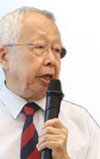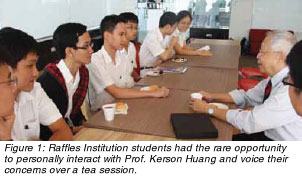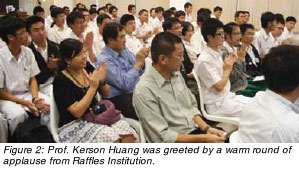|
by Tan Guoxian
 Professor Kerson Huang "My World of Physics" Professor Kerson Huang "My World of Physics"
Every year, numerous JC students have an important decision to deliberate on, contemplating which subject combination to read for A levels or which university degrees to pursue. To help these students, Professor Kerson Huang recently visited Raffles Institution to share insights into his world of physics and inspire these young curious minds. He explains why students should be taking physics, not just as a subject, but rather as a way of life.
by Tan Guoxian
The World of Physics in Singapore
January marks the beginning of a new academic calendar for many students, and this is an even more exciting time for fresh JC students who just joined the various JCs from their secondary schools. It is during this period of time that students select their various subjects to read at A-levels. It is a crucial decision, one that will determine their choice of subjects that they will be sitting for the all important A-levels, and ultimately affect their lives. Then there is another group of students who have just finished the A-levels and are preparing to embark on the next phase of their life journey. These students are riddled with the vast selection of university courses to cater to their different palettes and aspirations. In order to help these students better understand the choices they are making, MIT Professor of Physics Emeritus and Nanyang Professor of NTU, Professor Kerson Huang recently visited Raffles Institution (JC) to share insights into his world of physics.
Raffles DistinguishedProfessor Lecture Series
 Professor Kerson Huang engaged these young curious minds from Raffles Institution (JC) in the Raffles Distinguished Professor Lecture. The lecture, jointly organized by Raffles Institution and the Institute of Advanced Studies (IAS) at Nanyang Technological University, was attended by 150 physics students from the Raffles Academy, a platform specially designed to nurture peaks of excellence from the top few among their cohort. The Raffles Distinguished Professor Lecture Series regularly invites prominent professors from their respective research fields, counting among esteemed Nobel laureates such as Professor Douglas D. Osheroff (Physics, 1996) and Professor Claude Cohen-Tannoudji (Physics, 1997) under this initiative to give invited lectures and hold dialogue sessions. Professor Kerson Huang engaged these young curious minds from Raffles Institution (JC) in the Raffles Distinguished Professor Lecture. The lecture, jointly organized by Raffles Institution and the Institute of Advanced Studies (IAS) at Nanyang Technological University, was attended by 150 physics students from the Raffles Academy, a platform specially designed to nurture peaks of excellence from the top few among their cohort. The Raffles Distinguished Professor Lecture Series regularly invites prominent professors from their respective research fields, counting among esteemed Nobel laureates such as Professor Douglas D. Osheroff (Physics, 1996) and Professor Claude Cohen-Tannoudji (Physics, 1997) under this initiative to give invited lectures and hold dialogue sessions.
"Nature doesn't look at the world in terms of Physics, Chemistry or Biology. Why should we?"
Professor Kerson Huang
During the lecture “My World of Physics”, Professor Kerson Huang shared his views on his world of physics, engaging students on the fascinating interplay between biology and physics. Professor Kerson Huang recounted how, since the time of Galileo Galilei, the scientific world had always been fixated around explaining natural phenomenon which were observable to humans. Most of the scientific theories formulated during that era revolved around laws of classical physics in order to rationalize daily occurrences such as the formation of rainbows, or the rise and fall of tides. Professor Kerson Huang then went on to quote William Thomson who lived in the 19th century, better known as Lord Kelvin, the man who introduced the concept of the Kelvin scale, “There is nothing new to be discovered in physics now. All that remains is more and more precise measurements.,.”. Ironically, as William Thomson was saying this, new experiments would surface to reveal the world of atoms, in which the study of quantum mechanics would supersede the study of classical mechanics. It wasn’t until the late 19th century that more scientists started to take notice of the unobservable quantum phenomenon. This eventually led to a radical shift in mindset on how the leading scholars see, or rather “can’t see” the world today.
"Imagination is more important than knowledge"
Albert Einstein
 Professor Kerson Huang is widely accepted as a leading authority in quantum physics and he then went on to passionately discuss about his pet topic, the mysteries of cosmology and “dark energy”. What is even more intriguing is how he amalgamated both his passion and training as a physicist, with his latest work on a biological process. During the lecture, Professor Kerson Huang shared about his latest work on protein folding where laws governing particle physics were used to explain and predict the intricacies of how protein folding occurs. This was done through a novel stochastic method, CSAW, which allowed researchers to investigate the mechanisms of protein folding that lead to diseases. Professor Kerson Huang’s recent work in this area truly exemplifies his multi-disciplinary research approach, cleverly using quantum mechanics and thermodynamics to explain and predict how a biological process of protein folding occurs. Through the eyes of renowned quantum physicists Professor Kerson Huang, the students broadened their horizons and were enlightened by his dedication towards greater interdisciplinary in research to address pivotal challenges in the 21st century.
Professor Kerson Huang is widely accepted as a leading authority in quantum physics and he then went on to passionately discuss about his pet topic, the mysteries of cosmology and “dark energy”. What is even more intriguing is how he amalgamated both his passion and training as a physicist, with his latest work on a biological process. During the lecture, Professor Kerson Huang shared about his latest work on protein folding where laws governing particle physics were used to explain and predict the intricacies of how protein folding occurs. This was done through a novel stochastic method, CSAW, which allowed researchers to investigate the mechanisms of protein folding that lead to diseases. Professor Kerson Huang’s recent work in this area truly exemplifies his multi-disciplinary research approach, cleverly using quantum mechanics and thermodynamics to explain and predict how a biological process of protein folding occurs. Through the eyes of renowned quantum physicists Professor Kerson Huang, the students broadened their horizons and were enlightened by his dedication towards greater interdisciplinary in research to address pivotal challenges in the 21st century.
"New discoveries are happening at the interface between disciplines, for example, between engineering and medicine, and between biology and physics¡You cannot be a narrow specialist in the knowledge society, and much of our research funds are going into collaborative efforts to solve complex, multi-faceted problems."
Professor Bertil Andersson
NTU Provost and President-Designate
Kerson Huang’s World of Physics
In addition to the lecture on his world of physics, Professor Kerson Huang helmed a tea session with the students. The tea session was a platform for the candid exchange of ideas over a more cordial atmosphere meant to sow and nurture the seeds of budding young scientific minds. Professor Kerson Huang was overwhelmed with enthusiastic questions regarding his passion for research, his personal views on the differences between experimentalists and theorists, and he even commented that he would like to see more research in the area of Traditional Chinese Medicine over the next decade. Professor Kerson Huang described his growing up years as having taken place during World War II and that as a young, impressible boy; he initially did not conform well to the rigidity of the curriculum in school. It was only after he studied on his own, that his passion for physics grew and that he was empowered with the endless possibilities that physics has to offer. Interestingly, students got to know a lighter side of Professor Kerson Huang during this session where he shared some of his personal hobbies and how he spends his time now that he has retired. Indeed, through the glasses of one of the most eminent scientists of this century, it is the hope of Professor Kerson Huang that physics can be viewed as more than just a mere discipline but rather, as a way of life that can branch even into chemistry, biology, economics or finance.
"Look at physics as a way of life, and the language of physics would be mathematics, the greatest language you can learn¡"
Professor Kerson Huang
About the Speaker
Professor Kerson Huang, is a Chinese-American theoretical physicist born in 1928 in Nanning, China. He has been conferred the title of Professor of Physics Emeritus at MIT and elected a Fellow of the prestigious American Physical Society (APS), and the American Academy of Arts and Sciences. Professor Kerson Huang received his SB degree in physics in 1950, and PhD in physics in 1953, both at MIT. He then went on to join the physics faculty at MIT in 1957. Prior to his tenure as a faculty member at MIT, he had a stint at the Institute of Advanced Study, Princeton, as well as at the Alcatel-Lucent Bell labs. Throughout his academic career, Professor Kerson Huang has worked closely with Physics Nobel Laureates (1957), C.N. Yang and T.D. Lee, who gained recognition for their work in particle physics. Many contributions of Professor Kerson Huang include works on Bose-Einstein condensation, quantum field theories and protein folding. He has worked on the theory of interacting bosonic particles, particularly phase diagrams, and superfluid pinning in a random potential. One of his many contributions in quantum field theory includes the discovery of asymptotically free scalar fields in 4D, which were generally thought to be impossible.
Currently his interest centers on protein structure, especially the dynamics of protein folding. One of his recent works in the field of BioPhysics on protein folding has garnered much renewed interest in stochastic modeling using Self-Avoiding Walk (SAW) and Monte Carlo simulations. He is also the advisor to Nanyang Technological University SPMS Proteins Folding Research Project, where he’s also involved in Bio-Physics, High Energy Physics and Statistical Mechanics projects, as well as the International Science Youth Forums.
 Click here to download the full issue for USD 6.50 Click here to download the full issue for USD 6.50
|


 Professor Kerson Huang "My World of Physics"
Professor Kerson Huang "My World of Physics"
 Professor Kerson Huang engaged these young curious minds from Raffles Institution (JC) in the Raffles Distinguished Professor Lecture. The lecture, jointly organized by Raffles Institution and the Institute of Advanced Studies (IAS) at Nanyang Technological University, was attended by 150 physics students from the Raffles Academy, a platform specially designed to nurture peaks of excellence from the top few among their cohort. The Raffles Distinguished Professor Lecture Series regularly invites prominent professors from their respective research fields, counting among esteemed Nobel laureates such as Professor Douglas D. Osheroff (Physics, 1996) and Professor Claude Cohen-Tannoudji (Physics, 1997) under this initiative to give invited lectures and hold dialogue sessions.
Professor Kerson Huang engaged these young curious minds from Raffles Institution (JC) in the Raffles Distinguished Professor Lecture. The lecture, jointly organized by Raffles Institution and the Institute of Advanced Studies (IAS) at Nanyang Technological University, was attended by 150 physics students from the Raffles Academy, a platform specially designed to nurture peaks of excellence from the top few among their cohort. The Raffles Distinguished Professor Lecture Series regularly invites prominent professors from their respective research fields, counting among esteemed Nobel laureates such as Professor Douglas D. Osheroff (Physics, 1996) and Professor Claude Cohen-Tannoudji (Physics, 1997) under this initiative to give invited lectures and hold dialogue sessions.
 Professor Kerson Huang is widely accepted as a leading authority in quantum physics and he then went on to passionately discuss about his pet topic, the mysteries of cosmology and “dark energy”. What is even more intriguing is how he amalgamated both his passion and training as a physicist, with his latest work on a biological process. During the lecture, Professor Kerson Huang shared about his latest work on protein folding where laws governing particle physics were used to explain and predict the intricacies of how protein folding occurs. This was done through a novel stochastic method, CSAW, which allowed researchers to investigate the mechanisms of protein folding that lead to diseases. Professor Kerson Huang’s recent work in this area truly exemplifies his multi-disciplinary research approach, cleverly using quantum mechanics and thermodynamics to explain and predict how a biological process of protein folding occurs. Through the eyes of renowned quantum physicists Professor Kerson Huang, the students broadened their horizons and were enlightened by his dedication towards greater interdisciplinary in research to address pivotal challenges in the 21st century.
Professor Kerson Huang is widely accepted as a leading authority in quantum physics and he then went on to passionately discuss about his pet topic, the mysteries of cosmology and “dark energy”. What is even more intriguing is how he amalgamated both his passion and training as a physicist, with his latest work on a biological process. During the lecture, Professor Kerson Huang shared about his latest work on protein folding where laws governing particle physics were used to explain and predict the intricacies of how protein folding occurs. This was done through a novel stochastic method, CSAW, which allowed researchers to investigate the mechanisms of protein folding that lead to diseases. Professor Kerson Huang’s recent work in this area truly exemplifies his multi-disciplinary research approach, cleverly using quantum mechanics and thermodynamics to explain and predict how a biological process of protein folding occurs. Through the eyes of renowned quantum physicists Professor Kerson Huang, the students broadened their horizons and were enlightened by his dedication towards greater interdisciplinary in research to address pivotal challenges in the 21st century.
 Click here to download the full issue for USD 6.50
Click here to download the full issue for USD 6.50